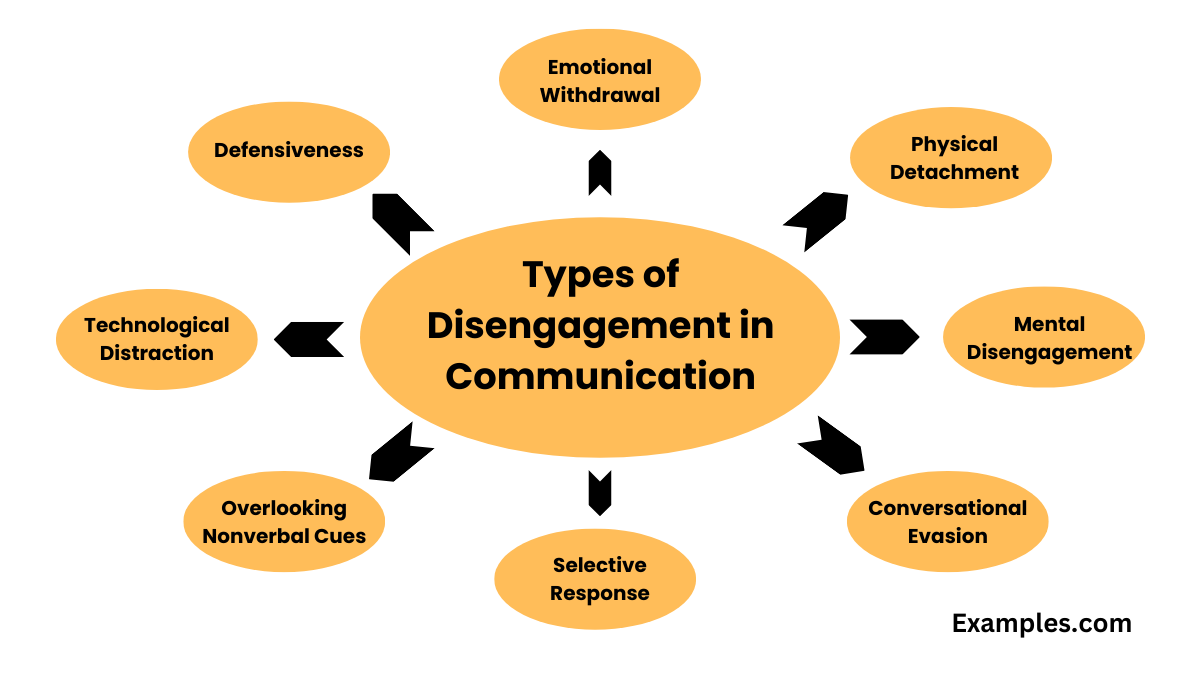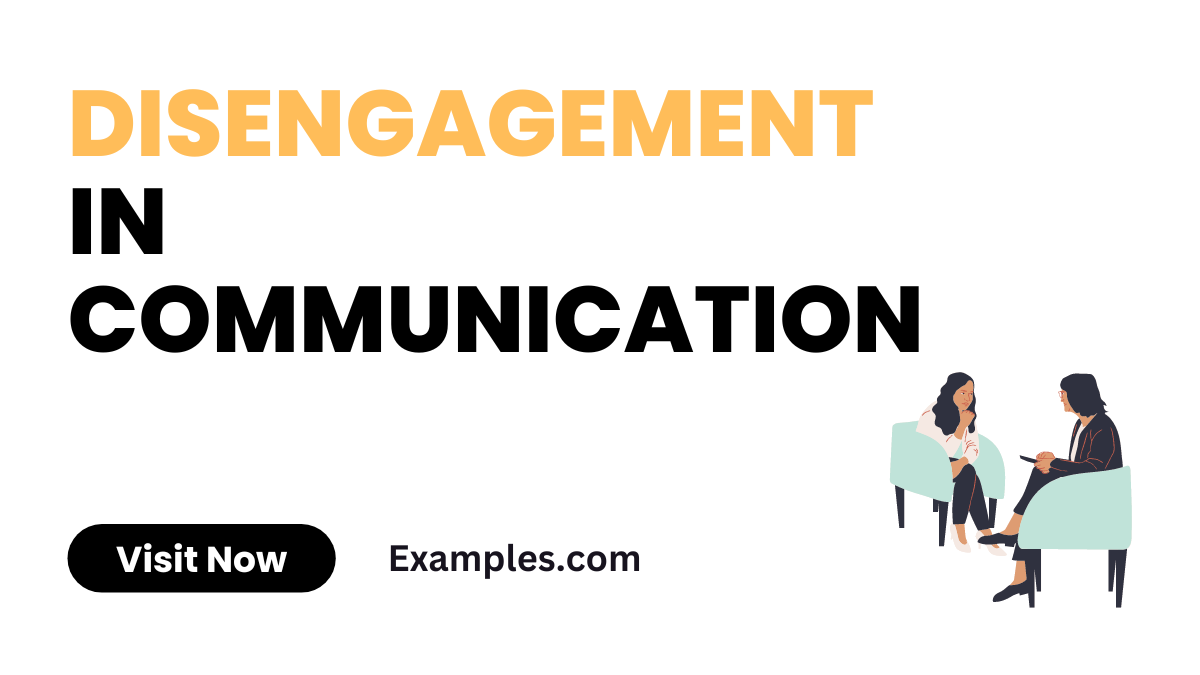19+ Disengagement in Communication Examples
In today’s interconnected world, understanding disengagement in communication is crucial. This phenomenon, often overlooked, can significantly hinder personal and professional relationships. Our guide delves into the nuances of disengagement, offering insightful analysis and practical solutions. From recognizing subtle cues to implementing effective strategies, we cover all you need to know about navigating and improving communication dynamics. Elevate your communication skills by mastering the art of engagement.
What is Disengagement in Communication?

Disengagement in communication occurs when one or more parties in an interaction withdraw, either emotionally, mentally, or physically, leading to a breakdown in effective exchange of ideas. This phenomenon can manifest in various forms, such as reduced eye contact, minimal response, or a lack of interest in the conversation.
What is the Best Example of Disengagement in Communication?

Disengagement in communication occurs when one or more parties involved in a conversation detach themselves from the interaction. A classic example of disengagement is when individuals are physically present in a meeting or conversation but are mentally absent. They may be distracted by personal thoughts, electronic devices, or external factors, leading to a lack of active listening and response. This type of disengagement undermines effective communication, as it hinders understanding, empathy, and meaningful interaction.
20 Examples of Disengagement in Communication
Disengagement in communication is a critical barrier, manifesting through various behaviors that signal a lack of interest or avoidance in interactions. These signs include avoiding eye contact, giving monosyllabic responses, frequently checking devices, using closed body language, and providing non-committal answers. Identifying these signs is key to understanding and improving interpersonal communication dynamics
1. Avoiding Eye Contact: Often indicates disinterest.
Example: A person looks away while you are speaking, signaling they are not fully engaged.
2. Short or Monosyllabic Responses: Shows lack of enthusiasm.
Example: Responding with just “Hmm” or “Okay” to detailed questions.
3. Frequently Checking the Clock or Phone: Suggests impatience or distraction.
Example: A listener repeatedly glances at their watch during a conversation.
4. Changing the Subject Quickly: Can indicate discomfort or disinterest in the topic.
Example: Swiftly moving the conversation to another topic without acknowledging the current one.
5. Not Responding to Messages: Implies avoidance or lack of interest.
Example: Ignoring emails or texts related to a specific discussion.
6. Using Closed Body Language: Non-verbal cue of disengagement.
Example: Arms crossed and minimal nodding while conversing.
7. Minimal Participation in Discussions: Indicates lack of engagement or interest.
Example: Contributing very little in a group discussion.
8. Interrupting or Talking Over Others: Shows disrespect and lack of interest in others’ views.
Example: Cutting someone off mid-sentence consistently.
9. Sighing or Showing Exasperation: Non-verbal signs of frustration or boredom.
Example: Audible sighs during a conversation.
10. Overuse of Filler Words: Reflects disinterest or lack of preparation.
Example: Excessive use of “um,” “like,” or “you know” when responding.
11. Providing Vague or Non-Committal Answers: Demonstrates lack of investment in the conversation. Example: Using ambiguous phrases like “maybe” or “we’ll see.”
12. Fidgeting or Distracting Behaviors: Indicates restlessness or lack of focus.
Example: Tapping fingers or looking around the room instead of paying attention.
13. Repeating Phrases like ‘I don’t know’: Signifies disinterest or avoidance.
Example: Frequently using “I don’t know” to avoid deeper discussion.
14. Giving Undivided Attention to Something Else: Suggests prioritizing other interests.
Example: Paying more attention to a TV or computer screen.
15. Rarely Initiating Conversation: Reflects reluctance or disinterest in communication.
Example: Never starting a conversation or bringing up new topics.
16. Using a Monotone Voice: Can indicate boredom or disinterest.
Example: Speaking in a flat, unenthusiastic tone.
17. Being Evasive or Avoiding Direct Answers: Shows reluctance to engage fully.
Example: Sidestepping questions or giving incomplete answers.
18. Not Asking Questions or Showing Curiosity: Indicates lack of interest in the dialogue.
Example: Never asking follow-up questions or clarifications.
19. Dismissing or Minimizing the Other Person’s Comments: Shows lack of respect or interest.
Example: Responding with “That doesn’t matter” or “It’s not important.”
20. Making Excuses to Leave Conversations: Demonstrates avoidance.
Example: Often finding a reason to end a conversation prematurely.
How Do You Overcome Disengagement in Communication?
- Active Listening: Practice active listening by giving full attention to the speaker, acknowledging their message, and responding thoughtfully.
- Engaging Questions: Ask open-ended questions to encourage deeper conversation and show genuine interest in the speaker’s perspective.
- Feedback Mechanisms: Implement regular feedback sessions where both parties can express their thoughts and feelings about the communication process.
- Building Rapport: Develop a rapport with your communication partner by finding common ground and shared interests.
- Mindful Speaking: Be aware of your own communication style, ensuring it is clear, concise, and considerate of the listener’s viewpoint.
Disengagement in Communication at Workplace
- Regular Check-Ins: Schedule regular meetings to discuss project progress and address any concerns.
- Team Building Activities: Foster team cohesion and communication through team-building exercises.
- Transparent Communication Channels: Establish open channels of communication where employees feel comfortable sharing their thoughts.
- Recognize Achievements: Acknowledge and celebrate the achievements of team members to boost morale.
- Training Programs: Implement communication skills training programs to enhance employee engagement.
Causes of Disengagement in Communication
- Lack of Interest: Disinterest in the topic or conversation can lead to disengagement.
- Emotional Disconnect: Emotional barriers such as stress or personal issues can impede effective communication.
- Inadequate Communication Skills: Poor communication skills can lead to misunderstandings and disengagement.
- Environmental Distractions: External factors like noise or interruptions can disrupt focus.
- Mismatched Communication Styles: Differences in communication preferences can cause disconnects.
Types of Disengagement in Communication

- Emotional Withdrawal: Avoiding emotional involvement in conversations.
- Physical Detachment: Non-participation in discussions or meetings.
- Mental Disengagement: Lack of focus or interest in the communication process.
- Conversational Evasion: Skirting around important topics or avoiding direct answers.
- Selective Response: Responding only to certain parts of the conversation.
- Overlooking Nonverbal Cues: Ignoring body language and facial expressions.
- Technological Distraction: Allowing devices or screens to distract from face-to-face interaction.
- Defensiveness: Building barriers in conversation due to perceived criticism or conflict.
Mastering the art of effective communication is crucial. To avoid disengagement, focus on clear, concise, and engaging messaging. Use active voice, employ relatable examples, and maintain a conversational tone. Proper formatting, with headings and bullet points, enhances readability. Incorporate relevant keywords naturally to boost SEO. By adhering to these guidelines, you can ensure your communication resonates with your audience, fostering meaningful connections.



